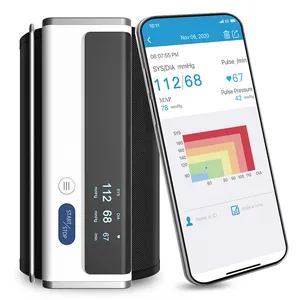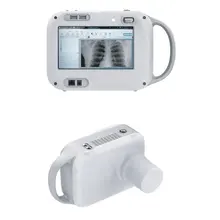What are Pressure Monitors
Pressure monitors, commonly known as blood pressure monitors, are medical devices used to measure and display the pressure exerted by circulating blood on the walls of blood vessels. They serve as vital tools in the healthcare industry, particularly for monitoring cardiovascular health. These devices are essential for individuals diagnosed with hypertension or other heart-related conditions, allowing both patients and healthcare professionals to track blood pressure readings regularly.
The principle of operation for a pressure monitor involves the application of a cuff around the patient's arm, which is then inflated to restrict blood flow. Once inflated, the device measures the force needed to overcome the pressure in the arteries and records systolic and diastolic pressures. The systolic pressure indicates the force at which the heart pumps blood around the body, while diastolic pressure reflects the resistance to the blood flow in the blood vessels.
Modern pressure monitors come in two main types: manual and automatic. Manual devices, known as sphygmomanometers, require a stethoscope and are typically used by healthcare professionals. In contrast, automatic or digital monitors are user-friendly and designed for home use, providing a digital readout of blood pressure levels. These devices work on oscillometric measurement principles, which detect blood movement through arteries and convert this movement into digital readings.
Types of Pressure Monitors
The market offers a variety of pressure monitors catering to different needs and preferences:
Digital Arm Monitors: These are among the most accurate types of blood pressure monitors. They come with a cuff that wraps around the upper arm and an electronic gauge that displays the readings. These devices are convenient for home use and are frequently used in medical settings.
Wrist Monitors: Compact and portable, wrist monitors are suitable for people who travel frequently or have difficulty using arm cuffs. However, they require proper positioning at heart level to ensure accuracy.
Manual Blood Pressure Monitors (Sphygmomanometers): These traditional devices include an inflatable arm cuff, a squeeze bulb for inflation, and a mercury or aneroid gauge to measure pressure. They are less common for personal use but remain prevalent in clinical settings.
Ambulatory Blood Pressure Monitors: Designed for continuous monitoring over 24 hours or longer, these monitors are typically used in a medical setting to diagnose hypertension patients who experience white coat hypertension or have borderline high blood pressure readings.
How to choose Pressure Monitors
When selecting a pressure monitor for business use, considering your clientele's needs is critical. For healthcare providers who value precision and durability, an upper-arm digital monitor is often preferred due to its accuracy and ease of use for staff members. In contrast, wrist monitors might be more suitable for businesses catering to travelers or those with dexterity issues.
It's important to consider the power supply mode as well—models with built-in batteries reduce ongoing costs but may need charging facilities, whereas those with removable batteries offer convenience but require battery replacements. Quality certification is also crucial; look for devices certified by recognized standards such as ISO13485 to ensure reliability.
Lastly, consider after-sale service options like return and replacement policies that can provide reassurance to businesses purchasing monitors in bulk. Customization support like ODM offers businesses an opportunity to tailor products to specific requirements, potentially adding value to their offerings.
Best Pressure Monitors on Alibaba.com
Alibaba.com stands out as an exceptional marketplace for sourcing wholesale pressure monitors suitable for all business needs. With its vast selection from various suppliers worldwide, Alibaba.com offers access to a wide range of monitors from manual sphygmomanometers to advanced digital models with various features such as memory storage, large displays, and portability options like wrist monitors.
The platform's commitment to connecting buyers with reputable suppliers ensures that businesses can find products that meet safety standards and quality certifications necessary for medical equipment. Moreover, Alibaba.com's Trade Assurance service gives additional peace of mind by safeguarding payments until delivery is confirmed.
Businesses looking to equip themselves with state-of-the-art medical devices will find Alibaba.com's interface user-friendly and accommodating—whether from a desktop or mobile device—and support is available in multiple languages. This streamlined process makes it simpler than ever for businesses worldwide to keep up with high demand while ensuring they provide reliable health monitoring tools to their end-users.
Common FAQs for Pressure Monitors
What factors should be considered when purchasing pressure monitors for a healthcare facility?
When purchasing pressure monitors for a healthcare facility, it's important to consider the accuracy of the devices, the types of monitors suitable for your patient population (arm vs. wrist), the ease of use for healthcare professionals, and whether the devices meet regulatory quality certifications.
How do different types of pressure monitors vary in terms of accuracy?
Accuracy can vary depending on the type of pressure monitor. Generally, upper-arm digital monitors are known for higher accuracy, while wrist monitors may require more precise positioning and can be sensitive to body position and movement.
Can pressure monitors be customized to match a healthcare provider's branding or specific needs?
Yes, many suppliers offer customization support such as ODM and OBM, allowing businesses to tailor pressure monitors to align with branding or incorporate specific features requested by healthcare providers.
What after-sale services are typically available for bulk purchases of pressure monitors?
After-sale services for bulk purchases can include return and replacement policies. It's crucial to check with suppliers about their specific after-sale service options when making a purchase.
Are there pressure monitors suitable for patients with arrhythmia?
Some digital pressure monitors come with enhanced algorithms designed to provide accurate readings even in patients with irregular heartbeats or arrhythmia. It's important to verify this feature with the supplier before purchase.
What quality certifications should be looked for in pressure monitors?
Quality certifications such as ISO13485, ROHS, and FCC are important as they indicate that the pressure monitors have met specific standards for safety and performance in the medical devices industry.
How important is the power supply mode in choosing a pressure monitor?
The power supply mode is an important factor as it affects the portability and operational costs. Devices with built-in batteries may offer convenience but need charging facilities, whereas those with removable batteries or USB recharge options might provide more flexibility.
What safety standards do pressure monitors adhere to?
Pressure monitors should adhere to recognized safety standards like Gb15979-2002 and Gb/t18830-2009, which ensure that the devices are safe for use by both patients and healthcare professionals.
How does an ambulatory blood pressure monitor differ from regular home use monitors?
Ambulatory blood pressure monitors are designed for continuous monitoring over 24 hours or more and are commonly used to diagnose hypertension accurately by assessing a patient's blood pressure throughout their normal daily activities.
Can wrist blood pressure monitors be used in a professional healthcare setting?
While wrist blood pressure monitors are compact and convenient, they are generally less accurate than upper-arm models and may not be suitable as the primary device in a professional healthcare setting. They can be used as supplementary devices or in specific circumstances where arm cuffs are not practical.

































 浙公网安备 33010002000092号
浙公网安备 33010002000092号 浙B2-20120091-4
浙B2-20120091-4